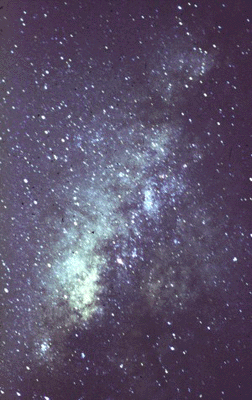(from Science Now, November 20, 2000)
Careful astronomical sleuthing may have finally divided the Milky Way's long history into distinct chapters of star formation. By observing more old stars than ever before, astronomers have now shown that you can tell how long a star has been hanging around in the galaxy by measuring its abundances of scarce heavy elements.
 |
Stars are like factories for heavy elements. A barrage of neutrons in the star transforms elements lighter than iron into heavier atoms like barium, europium, strontium, yttrium, and zirconium. A factory's lifetime output depends on its mass: Larger stars burn hotter and churn out heavy elements faster than smaller stars do. Each generation of stars forms from pristine gas mixed with leftovers of older stars that exploded, so astronomers can tell the rough order in which stars formed by looking at the abundances of heavy elements contributed by each previous generation. But this relationship is only clear for the first couple of generations of stars in a galaxy. Older stars in the Milky Way, for example, have inherited heavy metals from several earlier generations of stars, blurring the fingerprints of each individual generation.
Now an exhaustive multiyear search with the Mayall 4-meter telescopes at Kitt Peak National Observatory near Tucson, Arizona, has turned up six dozen precious old stars that contain traces of heavy elements from the first generation of Milky Way stars. That's not many stars, but it's enough to put together a timeline of galactic epochs for the early history of the Milky Way. A team led by astronomer Catherine Pilachowksi of the National Optical Astronomy Observatory in Tucson deduced the elemental abundances of each star despite their extremely faint light. The team reports in the 20 November issue of the Astrophysical Journal that the 13-billion-year history of the Milky Way can be split into five epochs, depending on the relative amounts of each heavy element. The researchers dubbed these the Prestellar Epoch, the Epoch of Very Massive Stars, the Europium Epoch, the Double Shell Epoch, and the Iron Epoch.
"There have been similar claims made before," says astronomer Andy McWilliams of the Carnegie Observatories in Pasadena, California, "but this large sample of stars has made them indisputable." One day the fingerprinting method may be used to nail down the evolutionary state of distant galaxies, but that will have to wait for the next generation of 10-meter telescopes, Pilachowksi says. Some such scopes are just now coming online.
--MARK SINCELL
Related sites
Catherine
Pilachowski's home page
The Kitt Peak National
Observatory